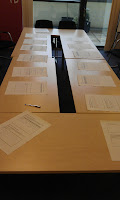Consultation on Draft National Curriculum
Consultation on Secondary School Accountability
Just as I wrote when the consultation on the EBCs was announced "If teachers (and others actually involved in Education) don't respond to the consultation, then the DfE will have no evidence of the depth of feeling about the changes. It's easy to send out disparaging tweets ... on twitter, but does take a bit of time to respond to the consultation. If we care about education, we should be willing to put time in to making our views known."
I'm re-posting my suggestion for an activity that could be used in staff meetings to help groups of teachers respond to the consultations.
It would take about 1 hour to do for each consultation, but the time could be shortened if needed.
Step 1: What does the consultation say?
Split the participants into groups of (of between 4 and 8)
and give each group a copy of the appropriate consultation document (printed onto single sided A4 paper) and a sheet of
flip chart paper which had been split into 8 pieces.
Each member of the group is given sections of the
consultation to read and then summarise on the flip chart pieces. Each section had to be summarised
on a separate piece of paper.
For the NC consultation I suggest the following sections are used:
The other sections are mainly procedural - although section 2 is about the structure of the NC.For the NC consultation I suggest the following sections are used:
- Section 1 - Background
- Section 6 - Aims of the National curriculum
- Section 7 - Programme of Study and Attainment targets (a big section!)
- Section 8 - ICT
- Section 9 - Equalities
- Section 10 - View of parents (or rather, should parents know what their children are learning at each stage of the NC)
- Section 11 - Implementation
- Section 12 - Phasing and disapplication
For the Accountability consultation more of the sections are relevant, but sections are generally shorter. I suggest sections 2 - 13 will need to be read, but these can be shared out amongst the group so that everyone has an approximately equal amount of reading to do.
It should take about 15 minutes to read and summarise each participant section of the document.
Step 2: Putting it
all together
Each member of the group uses their flipchart piece to
summarise what they have read and learnt.
This will take about 20 minutes. It
would be helpful if the group didn’t discuss what they heard at this point.
In this way the flipchart paper is rebuilt to provide an overview of the consultation as a whole.
In this way the flipchart paper is rebuilt to provide an overview of the consultation as a whole.
The group can now discuss the consultation, say what they thought, and suggest other possibilities, as well as share ideas between groups. This could take quite a while depending on how vocal people are.
Step 3: Answering the
questions
 Helpfully,
the Department for Education has provided a word
document for responses (NC consultation, Accountability consultation). Print
these out onto A3 sheets of paper and put them around the room in numerical
order.
Helpfully,
the Department for Education has provided a word
document for responses (NC consultation, Accountability consultation). Print
these out onto A3 sheets of paper and put them around the room in numerical
order.
The teachers can then wandered around, writing their answers and
thoughts to the questions, discussing further with each other as they did
so. They don’t have to respond to every question – just those you’ve got an opinion
about.
At the end of the session, collate the answers into
the word document and email it to participants. That way, when they answer the consultation
they have got a starting point to work from.
This process can be adapted depending on how many people you
have, or how much time you have. However, it is very important that teachers
give their views on these proposals, and I hope that this simple activity will
help you to do that by 16th April (NC) and 1st May (Accountability) .